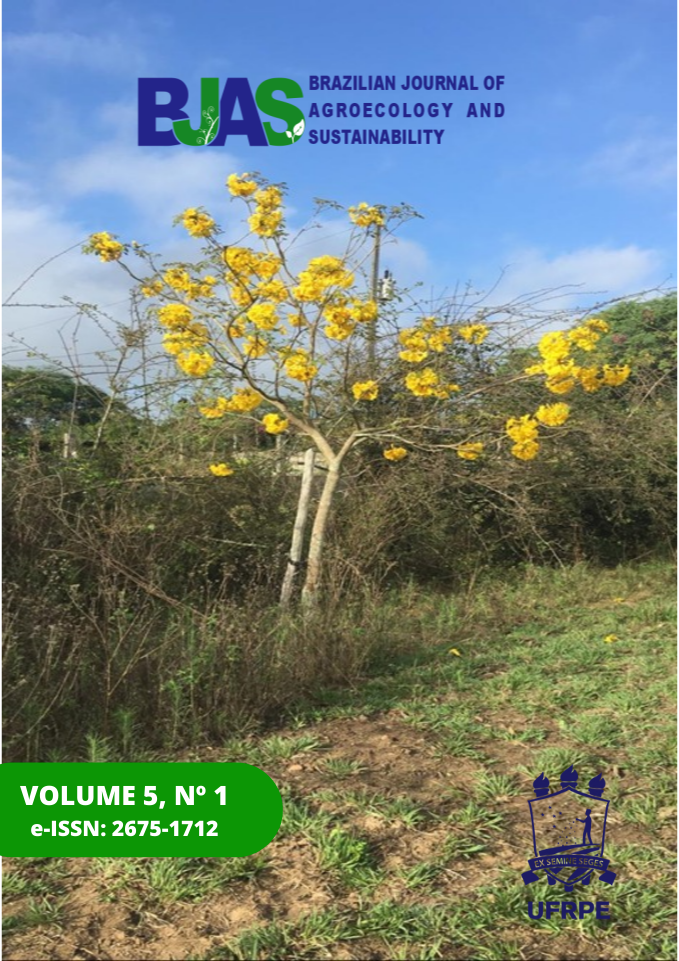Liquid extract of freshwater macroalgae on germination and initial development of Daucus carota L.
DOI:
https://doi.org/10.52719/bjas.v5i1.5546Keywords:
Biostimulant. Carrot. Seedling.Abstract
The use of natural biostimulants is present in the agricultural scenario, with seaweed-based extracts standing out for having favorable effects as fertilizers and phytosanitary products. This work aims to evaluate the effects of freshwater macroalgae extract on carrot seed germination. The experimental design consisted of four treatments, with five replicates containing 20 seeds each (n=100 seeds/treatment). The treatments were organized as follows: T1 (control – containing only distilled water); T2 (1% of algae extract); T3 (5% of algae extract); T4 (10% of algae extract). The experiment was carried out in the laboratory where the Petri dishes (replication) were placed in an incubator at 25°C and 12 hours of photoperiod. The evaluations were carried out daily by counting germinated seeds. Each one of the replicas was photographed to obtain the morphometric measurements (length of the root, stem, and leaves). The measurements were taken with the help of the Image J program. Concerning the carrot seed germination process, the results obtained from germination percentage, speed index, and average germination time revealed a possible allelopathic effect. For the initial development, a positive effect of the freshwater extract was observed (mainly about the treatments with 1% and 5%) on the biometric parameters, mainly with the root size. Although germination was impaired, the positive effects on early carrot growth show a biostimulant potential of the freshwater algae extract.Downloads
References
Araújo, J. M. H. (2017). Algas marinhas como bioestimulantes no crescimento inicial de espécies florestais da Caatinga (p. 47). Dissertação. Programa de pós graduação em Ciências Florestais, Universidade Federal do Rio Grande do Norte, Natal, Rio Grande do Norte, Brasil.
Becker, A. J. S. (2019). Tratamento de sementes de alface com bioestimulantes a base de algas (p. 53). Trabalho de Conclusão de Curso (Graduação) - Universidade Federal da Fronteira Sul, Chapecó, Santa Catarina, Brasil.
Costa, M. A. da, Nogueira, C. E. C., Alves, H. J., Marra, B. M., & Alab, J. H C. (2000). O uso de macroalgas marinhas na agricultura. Acta Iguazu, 3(2), 69–76.
Echert, T. T. (2019). “Uso de extratos de alga na agricultura” (p. 36). Trabalho de Conclusão de Curso. Faculdade de Agronomia da Universidade Federal do Rio Grande do Sul, Brasil.
Fan, D., Hodges, D. M., Zhang, J., Kirby, C.W., Ji, X., Locke, S. J., Critchley, A. T., & Prithiviraj, B. (2011). Commercial extract of the brown seaweed Ascophyllum nodosum enhances phenolic antioxidant content of spinach (Spinacia oleracea L.) which protects Caenorhabditis elegans against oxidative and thermal stress. Food Chem., 124, 195–202.
Jucoski, G. O., Cambraia, J., Ribeiro, C., & Oliveira, J. A. (2016). Excesso de ferro sobre o crescimento e a composição mineral em Eugenia uniflora. Revista Ciência Agronômica, 47(4), 720-728.
Kumar, G., & Sahoo, D. (2011). Effect of seaweed liquid extract on growth and yield of Triticum aestivum var. Pusa Gold. Biology Journal of Applied Phycology, 23, 251-255.
Labouriau, L. G. (1983). A germinação das sementes (p. 173). Washington, USA: Secretaria Geral da OEA.
Labouriau, L.G., & Valadares, M. B. (1976). On the germination of seeds of Calotropis procera. Anais da Academia Brasileira de Ciências, 48(1), 263-284.
Maguire, J. D. (1962). Speeds of germination-aid selection and evaluation for seedling emergence and vigor. Crop Science, Madison, 2, 176-177.
Neto, D. T. F. (2017). Extrato de Ascophyllum nodosum (L.) Le sob diferentes doses na cultura da soja (p.50). Dissertação (Mestrado em Agronomia) – Universidade Estadual do Norte do Paraná, Bandeirantes, Paraná, Brasil.
Rayorath, P., Jithesh, M. N., Farid, A., Khan, W., Palanisamy, R., Hankins, S. D., Critchley, A. T., & Prithiviraj, B. (2008). Rapid bioassays to evaluate the plant growth promoting activity of Ascophyllum nodosum (L.) Le Jol. using a model plant, Arabidopsis thaliana (L.) Heynh. J Appl Phycol., 20, 423–429.
Rodrigues Filho, J., Corte, V. B., Perin, T. A. L., Santos, C. R. dos, & Silva, R. da. (2020). Efeitos da toxicidade por ferro na germinação e crescimento inicial de Carica papaya L. Scientia Plena, 16(10), 1-12.
Sampaio, S. H. (2011). Avaliação dos teores de lipídios e proteínas e do perfil químico sob diferentes condições de cultivo da macroalga Stypopodium zonale Papenfuss (Dictyotales, Phaeophyta): Rio de Janeiro.
Serraglio, J. (2022). Germinação de sementes e desenvolvimento de plântulas de alface tratadas com diferentes bioestulantes a base de algas (p. 34). Trabalho de Conclusão de Curso, Universidade Federal da Fronteira Sul, Brasil.
Shukla, P. S., Borza, T., Critchley, A. T., & Prithiviraj, B. (2016). Carrageenans from red seaweeds as promoters of growth and elicitors of defense response in plants. Frontiers in Marine Science, 3, 1-9.
Silva, C. P. da, Garcia, K. G. V., Silva, R. M. da, Oliveira, L. A. A., & Tosta, M. S. (2012). Desenvolvimento inicial de mudas de couve-folha em função do uso de extrato de alga (Ascophyllum nodosum). Revista Verde de Agroecologia e Desenvolvimento Sustentável, 7(1), 07–11.
Sartore, N. (2021). Algas marinhas na agricultura é eficaz? Agro inovadores. https://agro.genica.com.br/2021/02/02/algas-marinhas-agricultura/.
Schuch, B. O. L., Kolchinski, M. E., Finatto, J. A. (2009). Qualidade fisiológica da semente e desempenho de plantas isoladas em soja. Revista Brasileira de Sementes, 31(1), 144-149.
Tófoli, R. J. (2017). Avaliação de biocompostos e composição numeral de extratos provenientes de duas macroalgas lóticas do estado de São Paulo (p. 58). Dissertação de Mestrado – Faculdade de Ciências e Letras de Assis – Universidade Estadual Paulista, São Paulo, Brasil.
Vieira, L. C., Lucas, D. C., Silva, M. B. P. da, Bedin, F., & Silva, V. N. (2021). Vigor de sementes de cenoura recobertas com bioestimulante de Solieria filiformis. Colloquium Agrariae, 17(1), 93-103.
Downloads
Published
How to Cite
Issue
Section
License
Copyright (c) 2023 Brazilian Journal of Agroecology and Sustainability

This work is licensed under a Creative Commons Attribution-NonCommercial-ShareAlike 4.0 International License.





